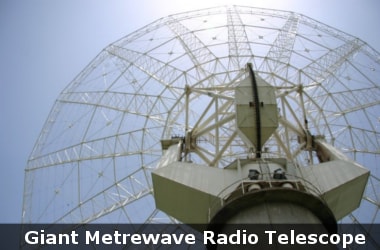
Astronomers, using data from India’s Giant Metrewave Radio Telescope (GMRT), have discovered two of the most powerful phenomena in the universe – a supermassive black hole and the collision of giant galaxy clusters about two billion light years from Earth.
The two phenomenon have combined to create a stupendous cosmic particle accelerator, researchers said and they found what takes place when matter ejected by a giant black hole is swept up in the merger of two enormous galaxy clusters.
This is the first time, however, that we see them clearly linked together in the same system and the cosmic double whammy is found in a pair of colliding galaxy clusters called Abell 3411 and Abell 3412 located about 2 billion light years from Earth.
The two clusters are both very massive, each weighing about a quadrillion - or a million billion - times the mass of the Sun.
The powerful electromagnetic fields associated with this structure have accelerated some of the inflowing gas away from the vicinity of the black hole in the form of an energetic, high-speed jet.
These accelerated particles in the jet were accelerated again when they encountered colossal shock waves – cosmic versions of sonic booms generated by supersonic aircraft -produced by the collision of the massive gas clouds associated with the galaxy clusters.
This discovery solves a long-standing mystery in galaxy cluster research about the origin of beautiful swirls of radio emission stretching for millions of light years, detected in Abell 3411 and Abell 3412 with the GMRT.
The galaxy clusters are known as Abell 3411 and Abell 3412, which are located about two billion light years from Earth.
Based on data obtained from the Chandra X-ray Observatory, the Giant Metrewave Radio Telescope (GMRT) in India, the Karl G. Jansky Very Large Array, the Keck Observatory, and Japan’s Subaru Telescope, the team was able to capture this event.
It was captured in the optical, x-ray, and radio wave wavelengths.